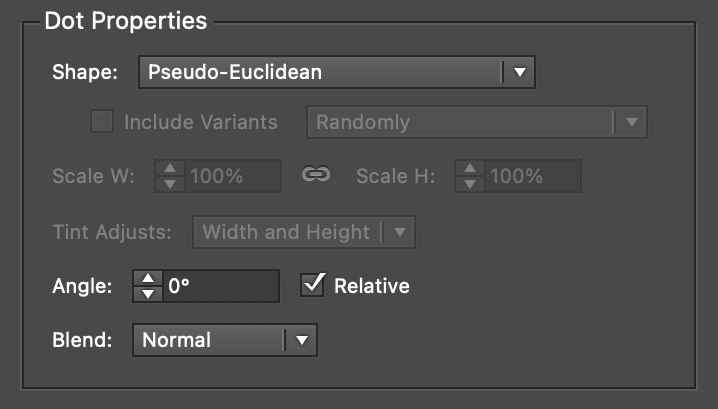- Getting Started
- Training
- Features
- Effects
-
Plugins
- AG Core
- AstuteBuddy
- Autosaviour
- ColliderScribe
- DirectPrefs
- DynamicSketch
- FindReplace
- InkFlow
- InkQuest
- InkScribe
- MirrorMe
- Phantasm
- Randomino
- Rasterino
- Reform
- Stipplism
- Stylism
-
SubScribe
- Getting Started
- Circle by Points Tool
- Tangent Circle Tool
- Curvature Circle Tool
- Arc by Points Tool
- Tangent Line Tool
- Perpendicular Line Tool
- Connect Tool
- Straighten Tool
- Lock Unlock Tool
- Orient Tool
- Quick Orient Tool
- Orient Transform Tool
- AG Layer Comps Panel
- Art Switcher Panel
- Gradiator Panel
- Gradient Forge Panel
- AG Color Select Tool
- Color Stamp
- Gradient From Art
- Pixels to Vector
- QuickOps
- Texturino
- VectorFirstAid
- VectorScribe
- WidthScribe
- FAQs
- Team Licensing
- Reseller Licensing
- Astute Manager
A Euclidean dot shape was traditionally produced with analog halftoning methods. It starts out as a circle, but as the tint approaches 50%, it transitions into a square. Therefore, at 50% tint, the halftone pattern is a checkerboard. At higher tint levels, the dots invert, with the gaps between the dots forming circles. Such a dot shape is difficult to implement as vector art as areas of tints greater than 50% would essentially have to form one large compound path. However, Phantasm’s Pseudo-Euclidean dot shape can often be an acceptable approximation when the DPI is set to a fairly high value.

Phantasm Halftone Dot Properties - Pseudo-Euclidean
Because the Pseudo-Euclidean dots assume many different shapes which must touch to give the illusion of a continuous, inverted field for tints over 50%, dot scaling is not allowed, and the scaling controls are dimmed. While the dot angle may be changed from the default of 0%, it generally leads to undesirable results. Relative Angle should always be enabled, for the same reason. The Blend parameter acts identically to the Circle dot shape (see above).

Phantasm Halftone Pseudo-Euclidean Comparison Example
Pseudo-Euclidean dots generally do a better job representing the tonality of the original artwork, especially in shadow areas, without the need to adjust the Dot Gain curve:

Phantasm Halftone Pseudo-Euclidean CMYK Comparison
